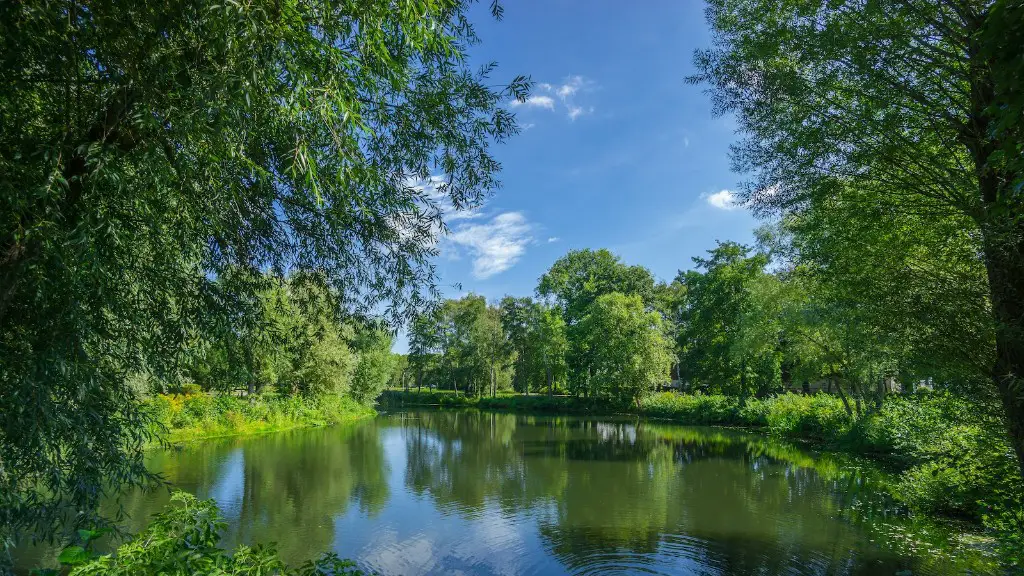The Mississippi River has been an important source of transportation, commerce and recreation in the United States since the earliest days of human habitation. In addition, this river has been a source of irrigation, flood control, and recreation. As the demands on the river have increased, so have the measures taken to protect against flooding and provide stability to its banks. One of the main measures of protection is the levees.
Levees are large embankments that are built to protect land from flooding. They are usually built around rivers, creeks, and other bodies of water as a way to protect the surrounding areas from flooding. Levees can be made of sand, dirt, or concrete. They are built along the rivers and creeks, and in some cases, the levees extend out into the gulf to help protect from storms and high tides.
In the case of the Mississippi River, levees are an extremely important part of its protection system. Levees were first built along the Mississippi River in the early 1800s, but most of the current system was built in the early 1900s to help protect the land from flooding. In the time since they have been built, the levees have become a vital component of the economy in the area, and have allowed people to build homes and businesses on land that would otherwise be too dangerous.
The levees along the Mississippi River span an incredible distance. According to an estimate by the U.S. Army Corps of Engineers, there are roughly 6,000 miles (9,656 km) of levees along the Mississippi River, making it one of the most protected rivers in the world. This has been a long and difficult process, as levees must be built to certain standards that make them sturdy enough to withstand the powerful forces of the river.
The cost of building and maintaining levees along the Mississippi River can also be quite high. The U.S. Army Corps of Engineers estimates that it costs approximately $100 million for every 100 miles of levees that are built. Even with the costs, however, the construction of levees is an important part of protecting both the infrastructure and the people that live near the river.
The levees along the Mississippi River serve an important purpose. They protect the land and people in the surrounding areas from flooding and provide stability to the banks of the river. The levees are also essential for allowing people to build homes and businesses on the land, which provides economic growth and stability to the communities in the area.
Impact Of Levees On The Environment
The levees along the Mississippi River have had a major impact on the environment. While they have been effective in preventing flooding, they have also limited the natural flow of the river. This has led to lower oxygen levels in the water, which can be harmful to fish, wildlife, and other organisms in the river. In addition, the levees can cause the river to erode its banks more quickly, leading to an increased risk of flooding.
The levees themselves can also have a negative environmental impact. In some cases, the soil used to construct the levees can be contaminated with pollutants, and the levees themselves can overturn and cause damage to the surrounding land. This is especially true in areas that have not been properly maintained, which can allow the levees to deteriorate over time.
In addition to the environmental impacts, the levees have also had a significant impact on the local economy. The building of the levees destroyed a number of wetlands in the area, which provided important habitat for wildlife and served as an important source of food and water for local communities. The wetland destruction also cut off important sources of irrigation, which further impacted the economy of the region.
In spite of the significant negative impacts, there are also some positive aspects of levees along the Mississippi River. For example, they have allowed the development of infrastructure along the river, which has led to an increase in transportation and commerce in the area. In addition, the levees have helped protect the land from flooding, and provided important stability to the banks of the river.
Future Of Mississippi Levees
The future of the levees along the Mississippi River is uncertain. Since the levees have been built, the area has seen significant population growth, as well as an increase in the severity of extreme weather. This leads to an increased risk of flooding, which could potentially render the current levee system ineffective. As such, it is important that the levees be monitored and maintained regularly to ensure they remain effective.
In addition, the levees along the Mississippi River are increasingly being impacted by climate change. Rising temperatures and increasingly intense storms are making the levees particularly vulnerable. This is due to the fact that warmer temperatures can lead to higher river levels, which can lead to increased erosion. In addition, increasing storm intensity can overwhelm the levees and lead to flooding.
In order to ensure the safety of the area, it is important that the levees along the Mississippi River be improved and maintained. This includes regular inspections and maintenance, as well as improvements to existing levees. In addition, new levees may need to be constructed in areas that are particularly vulnerable to flooding. However, it is important to remember that any changes to the levee system will likely have both positive and negative impacts on the area.
Economic Impact Of The Mississippi Levees
The Mississippi River levees have had a significant economic impact on the area. The levees have allowed for the growth of infrastructure and allowed people to build homes and businesses in areas that were once at risk of flooding. The levees have also helped spur economic development in the area, as businesses and people are now able to move into the area with more security.
The levees have also had a positive impact on the tourism industry in the area. The levees have helped protect the land from flooding, allowing more people to explore and enjoy the area in a safe manner. This has allowed businesses like boat tours, fishing guides, and other outdoor activities to flourish, creating an important source of income for the local economy.
In addition, the levees have opened up the Mississippi River for shipping and other forms of transportation. This has allowed goods and services to move up and down the river more quickly and efficiently, providing a boost to the local economy. The levees have also allowed the area to become a major port, allowing goods to be transported across the country.
The levees along the Mississippi River have also allowed for new forms of development in the area. The levees have helped reclaim and protect land, allowing businesses and people to build in areas that were once at risk of flooding. This has allowed for the construction of homes and new businesses, as well as new parks and recreational areas. All of this has had an incredibly positive impact on the economy in the area.
Risks Of Mississippi River Levees
Although the levees along the Mississippi River have had a number of benefits, there are also some risks associated with them. In some cases, the levees can become damaged, leading to a breach and potentially catastrophic flooding in the area. In addition, the levees are vulnerable to extreme weather and environmental threats, such as rising temperatures and increasing intensity of storms.
In addition, the levees can cause the river to erode its banks more quickly, leading to an increased risk of flooding. This is especially true in areas that have not been properly maintained, which can allow the levees to deteriorate over time. As a result, it is important to regularly monitor and maintain the levees in order to ensure they remain effective.
The levees along the Mississippi River have had a significant impact on the environment as well. The construction of the levees has destroyed a number of wetlands in the area, which provided important habitat for wildlife and served as an important source of food and water for local communities. In addition, as the levees age, they can become damaged, leading to contamination of the soil and water in the area.
Finally, the levees are also vulnerable to human interference. The levees can be weakened over time due to activities such as dredging or filling, which can lead to a decrease in the effectiveness of the levees. As such, it is important to be mindful of the activities that take place near the levees in order to ensure they remain effective.





